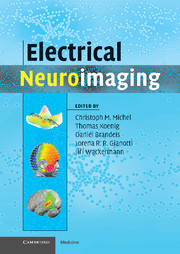Book contents
- Frontmatter
- Contents
- List of contributors
- Preface
- 1 From neuronal activity to scalp potential fields
- 2 Scalp field maps and their characterization
- 3 Imaging the electric neuronal generators of EEG/MEG
- 4 Data acquisition and pre-processing standards for electrical neuroimaging
- 5 Overview of analytical approaches
- 6 Electrical neuroimaging in the time domain
- 7 Multichannel frequency and time-frequency analysis
- 8 Statistical analysis of multichannel scalp field data
- 9 State space representation and global descriptors of brain electrical activity
- 10 Integration of electrical neuroimaging with other functional imaging methods
- Index
- References
9 - State space representation and global descriptors of brain electrical activity
Published online by Cambridge University Press: 15 December 2009
- Frontmatter
- Contents
- List of contributors
- Preface
- 1 From neuronal activity to scalp potential fields
- 2 Scalp field maps and their characterization
- 3 Imaging the electric neuronal generators of EEG/MEG
- 4 Data acquisition and pre-processing standards for electrical neuroimaging
- 5 Overview of analytical approaches
- 6 Electrical neuroimaging in the time domain
- 7 Multichannel frequency and time-frequency analysis
- 8 Statistical analysis of multichannel scalp field data
- 9 State space representation and global descriptors of brain electrical activity
- 10 Integration of electrical neuroimaging with other functional imaging methods
- Index
- References
Summary
The methods introduced in this chapter aim at a comprehensive assessment of the brain's functional state via a small number of “global” quantitative descriptors. Unlike the approaches presented in the preceding chapters, the objective of the global approach is not a mapping of the brain's functions within the real (physical) three-dimensional space, but rather a mapping of the variety of the brain's functional states into an abstract (mathematical) multidimensional space. Nevertheless, the global methodology shares with the other methods the focus on the spatial configuration of brain electrical fields, is closely related to microstate analysis, and as such belongs in the context of functional brain topography and electrical neuroimaging.
The state space representation
The notion of state space
The state, or temporary condition, of a given system is characterized by observations, usually in the form of measurements. For example, the weather situation at a given place and time may be assessed by measuring the temperature θ, the relative humidity h and the air pressure p. A convenient representation of the momentary state, which is characterized by three quantities, is a single point within a three-dimensional state space, located at coordinates (θ, h, p). The state space representation is useful in many cases because it gives an overview over all possible states of the system at once. Moreover, the evolution of the state over time appears as a movement within this space, or, disregarding time measure, as a path consisting of successive state points, the state space trajectory.
Information
- Type
- Chapter
- Information
- Electrical Neuroimaging , pp. 191 - 214Publisher: Cambridge University PressPrint publication year: 2009
References
Accessibility standard: Unknown
Why this information is here
This section outlines the accessibility features of this content - including support for screen readers, full keyboard navigation and high-contrast display options. This may not be relevant for you.Accessibility Information
- 4
- Cited by
